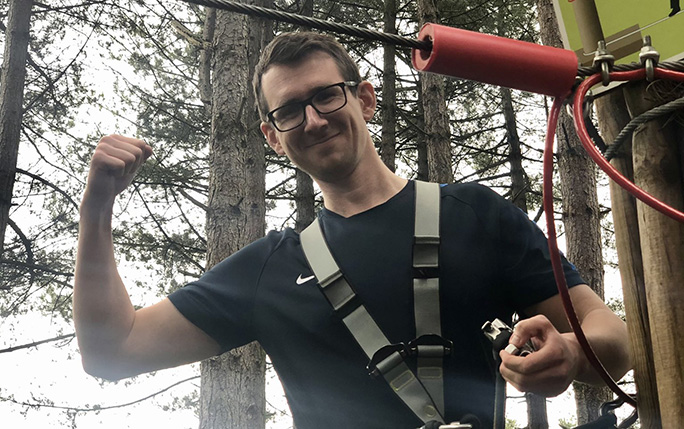PhD completed - Dr Roland Schnuerer

QUASAR Group member Roland Schnuerer successfully passed his PhD viva on Friday, 18 September 2020 with Dr Marco Gersabeck (U Manchester) and Prof Gianluigi Casse (U Liverpool/FBK) as his examiners. Roland's PhD focused on the development of a non-invasive, silicon-based beam monitor for medical accelerators.
In proton beam therapy knowledge of the detailed beam properties is essential to ensure effective dose delivery to the patient. Clinical settings currently implement interceptive ionisation chambers which require daily calibration and suffer from slow response times. With new and emerging treatment techniques using ultra high dose rates, there is a demand for the development of novel beam monitors, which are fast, non-invasive and calibration-free.
Roland's work presents a new non-invasive method for online dose monitoring. It is based on the multi-strip silicon sensor LHCb VELO (VErtex LOcator), developed originally for the LHCb experiment at CERN. The semi-circular detector geometry offers the possibility to correlate the beam intensity through halo measurements without interfering the beam core. Several adaptation needed to be carried out to transfer this technology from the CERN environment to a stand-alone setup. This included the development of a venting and cooling system for safe operation in air. A positioning system was also developed for a secure and precise handling of the modules.
The VELO detector modules were implemented at the 40 MeV proton beamline at the University of Birmingham, UK and synchronised with an ionisation chamber and the RF cyclotron frequency. This required a modification to the timing control of the readout boards. Proton beams with beam currents at different dose rates, from 0.2 nA to 6 nA, and different beam sizes, from a diameter of 7 mm to 20 mm, were precisely measured online using only the beam halo information.
Roland's experimental results demonstrate the linearity, accuracy, reproducibility and sensitivity of the VELO detector modules for a suitable use as a beam monitor. The standard deviation of the registered hits are very low and equal or below 1%. Furthermore, the results were used to derive a characteristic beam halo to dose relationship via comparison with beam tracking GEANT4 simulations and EBT3 GAFchromic film measurements.
His results have demonstrated the applicability of the VELO detector modules as a beam monitor for medical accelerators, however, his work also showed areas of improvement, e.g. it would be beneficial to upgrade the electronics hardware and pre-processing software to make the monitor more efficient and easier to integrate into existing setups.
Congratulations, Roland!